by Lisa Cooke | May 13, 2017 | 01 What's New, FamilySearch, Research Skills |
I have thoroughly enjoyed having Amie Tennant as a blogger for the past year. In her final blog post for Genealogy Gems she takes us on a tour of her home state’s digital records. Then she will be turning all of her attentions to her own genealogical certification. Thank you Amie for all of your helpful and thoroughly enjoyable posts! – Lisa Louise Cooke
Ohio genealogy research goes digital. You can now virtually walk into any courthouse in Ohio with the click of the mouse. Check out the amazing browse-only databases at FamilySearch for Ohio and other states, and take your family history research to the next level.
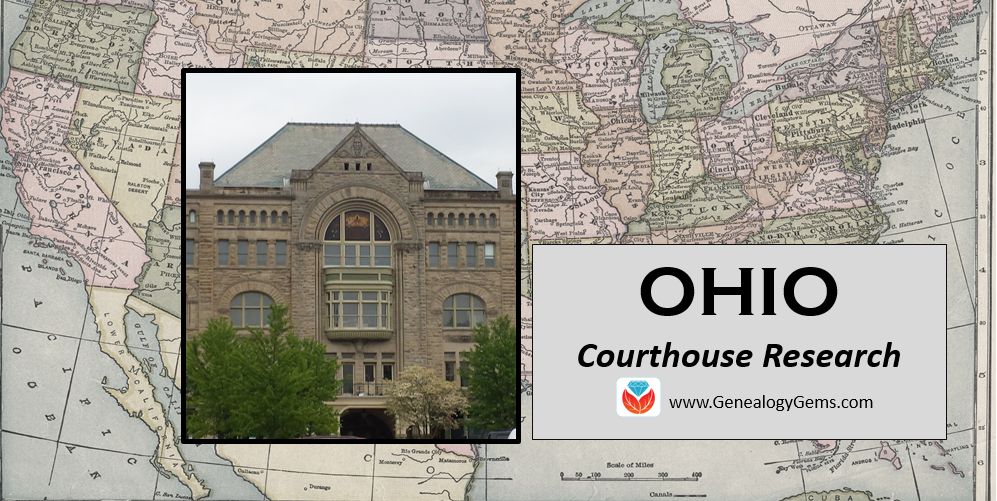
I use FamilySearch.org to search courthouse record books all the time. In particular, the Ohio Probate Records, 1789-1996 now have nearly 7 million digital images of county record books such as wills, estate files, guardianship records, naturalization records, minutes, bonds, and settlements. In fact, many other states have their court record books online at FamilySearch, too. So, why haven’t you noticed before?
Browse-only Databases vs. Indexed Databases
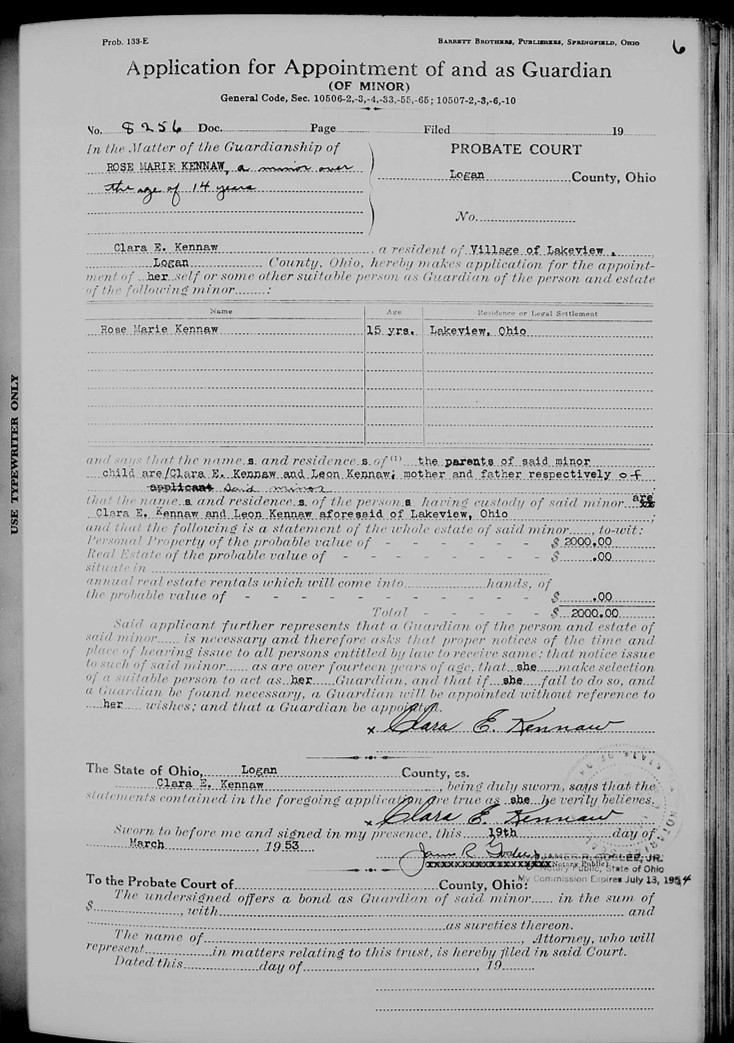 You may have read our previous post on step-by-step instructions to using browse-only databases at FamilySearch. If you didn’t, you should know that when you are searching for records at FamilySearch using the traditional search fields, you are only searching for records that have been indexed. In other words, there may be thousands of records you need on the site, but you won’t find them. They have not been indexed by a searchable name, place, or date. Instead, you need to go in the virtual “back door.”
You may have read our previous post on step-by-step instructions to using browse-only databases at FamilySearch. If you didn’t, you should know that when you are searching for records at FamilySearch using the traditional search fields, you are only searching for records that have been indexed. In other words, there may be thousands of records you need on the site, but you won’t find them. They have not been indexed by a searchable name, place, or date. Instead, you need to go in the virtual “back door.”
Step 1: First, go to FamilySearch and sign in. Next, click Search at the top right. Now you will see a map of the world. Click on the desired location. I have chosen the U.S., but you can choose any country you are interested in.
Step 2: Once you choose your desired country or continent, a pop-up list will be available and allow you to choose the state (or country) you wish to search in. In this case, a list of the U.S. states appears and I clicked on Ohio.
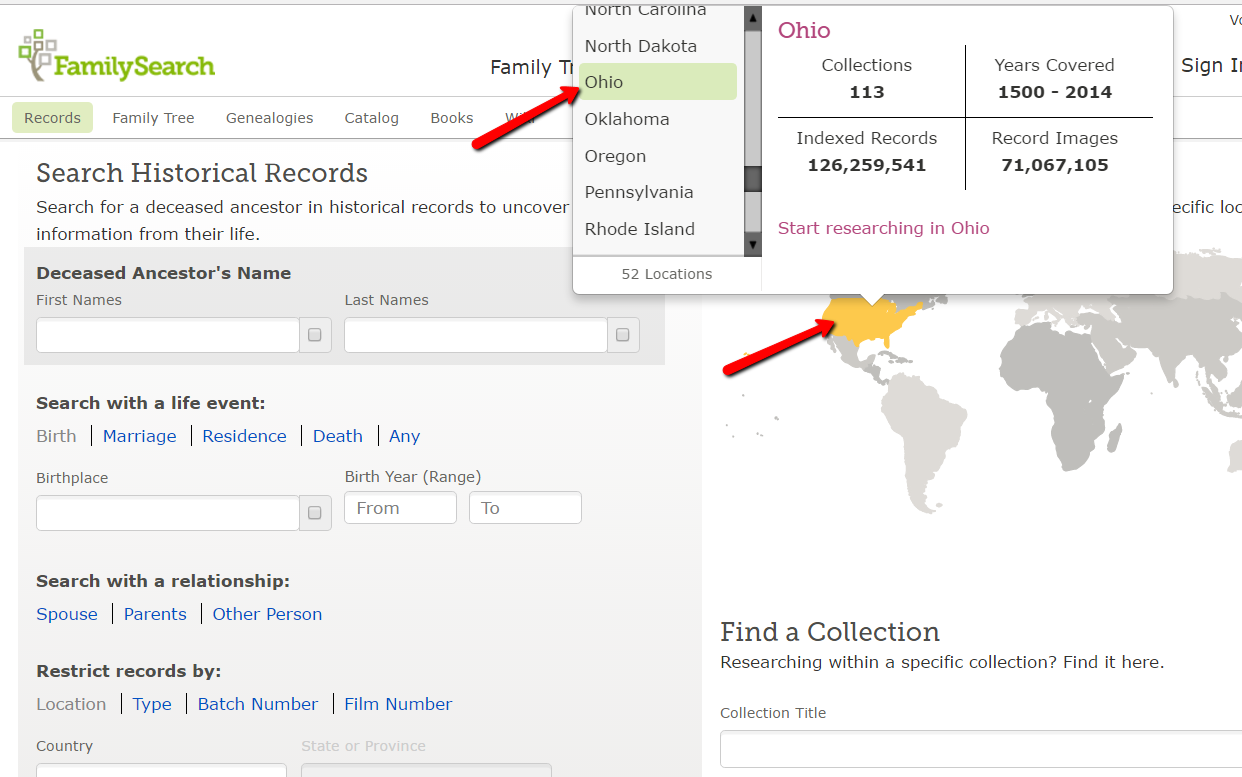
Step 3: The system will direct you to a new page. You will first see the Ohio Indexed Historical Records. These are the records and collections that have been indexed and are searchable by name, date, and place. Though these are great, they are not the record collections I want to share with you today.
Instead, scroll down until you see the heading Ohio Image Only Historical Records. You will notice several databases such as cemetery records, church records, naturalization records, etc. All of these are browseable. That means you will use them like you would microfilm.
Step 4: I want to bring your attention to a specific record collection, so scroll down even further until you see Ohio Probate Records, 1789-1996. Click it.
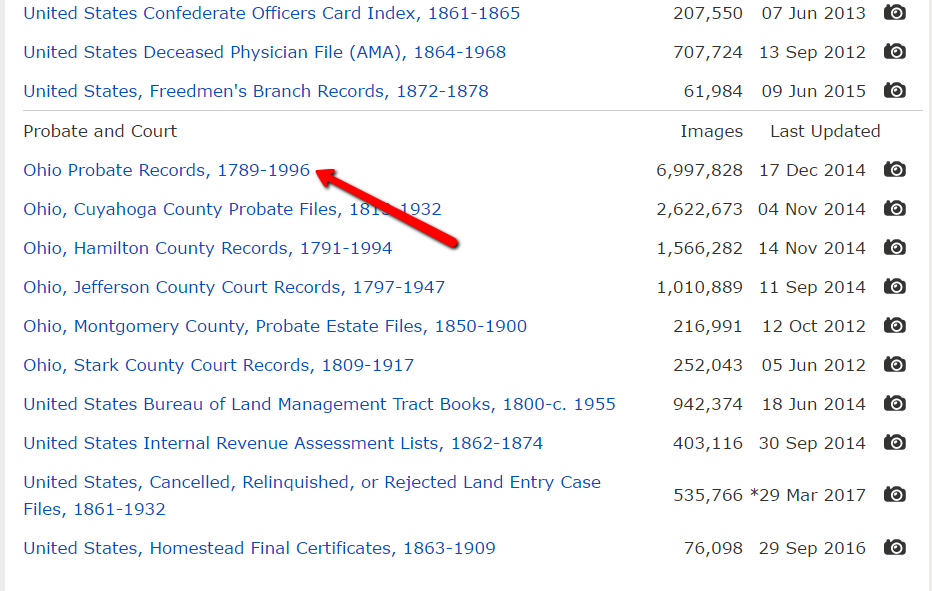
At the next screen, you will see you can browse the 6,997,828 Ohio probate records and you are probably thinking, “What!? I can’t possibly browse through nearly 7 million records!” But, you can, so go ahead and click it!
Step 5: At the new screen, you will see everything is broken up into counties. Click on the county you are interested in researching. You will next see a list of possible record books available for that county. Each county will vary, so where you may find guardianship records available in one county, you might not find them in another.
Ohio Genealogy Research at the Courthouse
As a refresher, courthouse research is often imperative to thorough genealogy research. Here is a helpful chart of the type of information you may find in these types of court records. Be sure to remember: records and the amount of information they contain change over time.
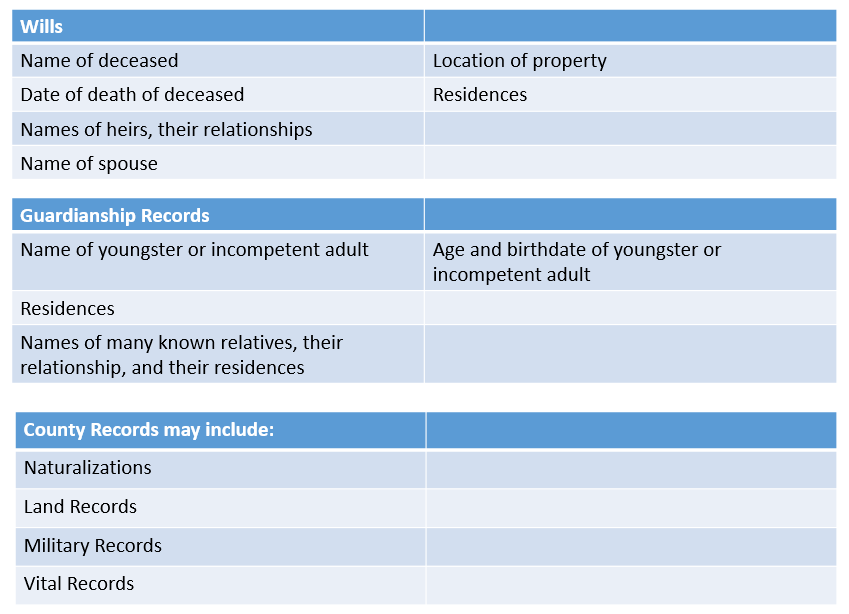
More on Courthouse Research Techniques
Are you looking to understand the value of courthouse research and how to use those records to overcome brick walls in your family tree? Read 4 Ways to Power Up Your Courthouse Research Skills from our own Sunny Morton.
by Lisa Cooke | Nov 2, 2016 | 01 What's New, Native American |
Here are the step-by-step instructions you need to know to effectively navigate the Dawes Applications for Native American research. Many American families have a tradition of Native American ancestry. Now through Nov. 15, 2016 Fold3 has made access to their Native American records collections free. Read on to gain a thorough knowledge of how to properly use these records and achieve research success! And sign up for our free Genealogy Gems newsletter for our upcoming posts on this important subject.
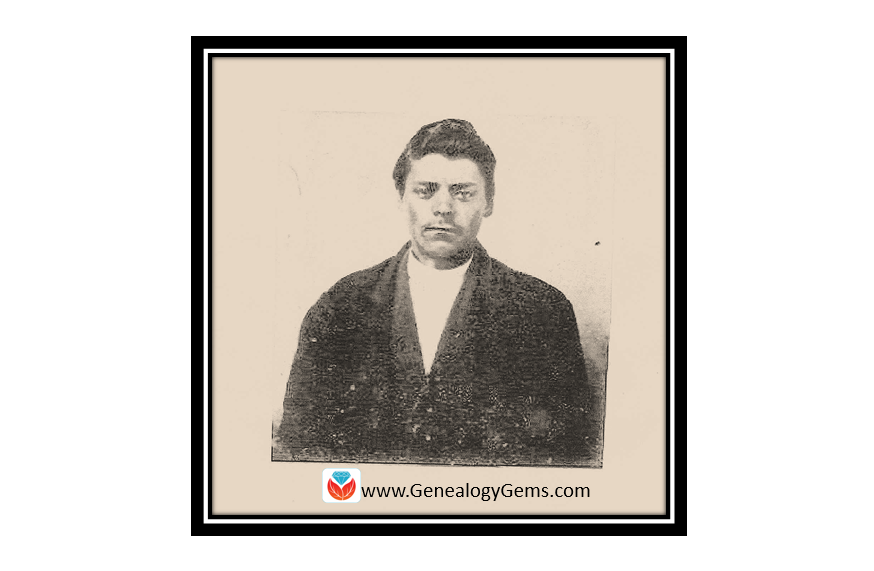
Dawes Applications for Native American Research
In 1893, an act of Congress approved the establishment of a commission to negotiate agreements with the Choctaw, Creek, Chickasaw, Seminole, and Cherokee Indian tribes. The commission became known as the Dawes commission. The commission was to divide tribal land into plots, which were then divided among the members of the tribe. The Commission either accepted or rejected applicants for tribal membership based on whether the tribal government had previously recognized the applicant as a member of the tribe. Applicants were categorized as Citizens by Blood, Citizens by Marriage, Minor Citizens by Blood, New Born Citizens by Blood, Freedmen (African Americans formerly enslaved by tribal members,) New Born Freedmen, and Minor Freedman.
Researching the Dawes Packets is tricky. One problem arises when researchers find their family members in an index and assume that means their family was a legitimate member of a tribe. That is not the case. You will find doubtful or even rejected applications as well.
The good news is that in applying, our ancestors provided lots of genealogically valuable details of their birth, residences, and family ties.
Let’s see how to use this special collection.
Dawes Packets are Listed By Application Number
It would take forever to go through the applications one by one to find your ancestor. You really need to check an index first, but Fold3 doesn’t have the index for the Dawes Packets collection available…at least as far as I have found.
Instead, I would suggest going over to Ancestry.com. There, click on Search and choose Card Catalog from the pull-down menu. In the keyword search at the card catalog, type in Five Civilized Tribes. This will give you the option of several databases, but the one we want to check first is the one titled “U.S., Native American Applications for Enrollment in Five Civilized Tribes, 1898-1914.”
Now, search for your targeted ancestor by name. In my example, I am going to search for David O. Scott.

The results indicate that David O. Scott appears in two entries. One entry gives the number of #9446 and the other is #616. I can view each of these records directly from Ancestry. The first image you see is a jacket cover, so just click the right arrow key to scroll through the digital pages contained in David’s file.
Remember, if you don’t have access to Ancestry.com, many local libraries and family history centers have free access for patrons. But, we are talking about using Fold3, so let’s pop back over there.
Go back to Fold3.com to access their Native American records. You will do this by clicking on Browse at the top of the Fold3 homepage. Next, scroll through the options and choose Non-Military Records. A new list of options will appear and you will click on Native American Collections, then Dawes Packets. The Dawes Packets that appear here on Fold3.com are first broke down into tribe, then by number.

David O. Scott’s search on Ancestry listed him as Cherokee, so I want to choose that tribe. One of his numbers was #616.

Did you notice the numbers have a “D” in front of them? These are the applications deemed “doubtful.” If you scroll down, the letter changes to “R.” These applications were rejected. We don’t know if David’s number 616 is in the doubtful category or the rejected category, so we will check both.
David’s #616 matches the D616 and now I know that his application was marked doubtful. David’s pages of information were packed with genealogical detail like family names, dates, and residences.
The 1896 Applications
Here’s another tip: Your ancestor may have applied in the first wave of applications submitted in 1896. Those applications were later deemed invalid and thrown out, but wow…you don’t want to overlook them! Whether your ancestor applied again in 1898 and you already found their Dawes Packet on Fold3, try looking at this collection as well.
The research center at the Oklahoma Historical Society webpage allows you to search the 1896 overturned applications index for free. I typed in the name of my third great-grandfather, Jacob Cole.

You can also search by tribe, however, I suggest you do not do that. Sometimes, individuals actually applied to more than one tribe because they were not sure which tribe they might belong to. By adding that criteria, you may miss your ancestor’s application all together.
Only one result appeared for Jacob Cole. On this result, you notice the tribe affiliation as Cherokee and the case/application number of 639. I will need that tribe and number to find the application at Fold3. [Note: As I mentioned earlier, this index does not tell me if Jacob’s application was accepted or rejected, but it really doesn’t matter because these applications were deemed invalid anyway.]
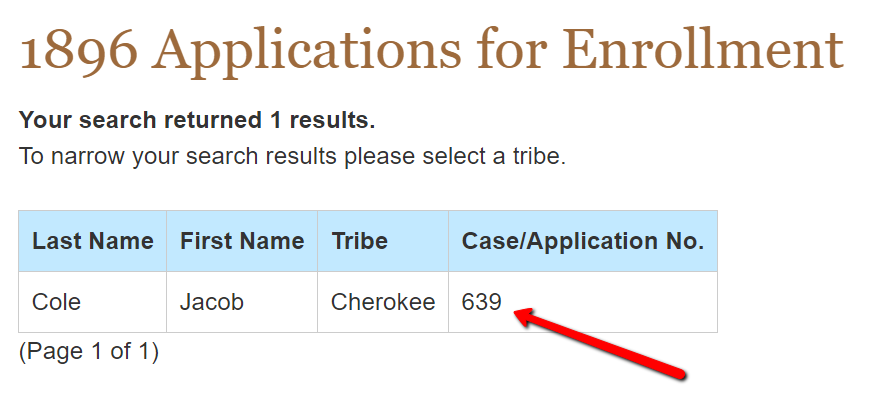
You won’t find Jacob’s overturned application of 1896 on Fold3 at this time, but it is available at Ancestry.
Where Can I find Overturned Applications for 1896?
Overturned applications from 1896 are still very valuable records. They can be found at the National Archives and Records Administration in Washington D.C., or at Ancestry.com.
Let’s look at Ancestry. Once at the homepage, click Search at the top, then choose Card Catalog from the pull-down options.
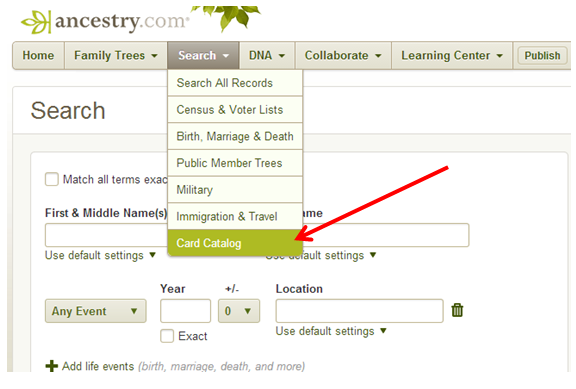 In the keyword field on the right, type in Five civilized tribes. You will see many options, but you want to click on the collection titled “U.S. Native American Applications for Enrollment in Five Civilized Tribes (overturned,) 1896.”
In the keyword field on the right, type in Five civilized tribes. You will see many options, but you want to click on the collection titled “U.S. Native American Applications for Enrollment in Five Civilized Tribes (overturned,) 1896.”

This next step is a bit tricky. You will be directed to a page that allows you to seemingly search for your targeted ancestor’s application. But, the search only searches an index for the applications. To find the entire application packet, you need to browse the microfilm by hand.
To do that, look over to the far right where it says Browse this collection. Choose from the drop-down menu which tribe your ancestor applied to…so, I will choose Cherokee Applications. Then, choose the roll number based on the application number of the packet. I can determine the correct roll number because Jacob’s application number was 639 and Roll 25 includes all applications between the numbers of 486 and 681.

Click ALL and a digital image of the microfilm pops up. You will need to browse image-by-image until you find your ancestor’s application number. Be patient. With more than 1800 images, it will take some time.
[Special Note: On the very last roll of microfilm, Roll 54, there are some miscellaneous files and applications that were received past the application deadline. These records were not included in the Master Index. If you did not find your targeted ancestor in the Master Index, check these miscellaneous records.]
I found Jacob’s application on digital image number 1405. His application packet was nine pages long. I learned the ages and names of his current wife and children, how he believes he is Cherokee through the blood of his grandfather, Hawk Bowman, and I read two witness statements about Jacob and his family.
In particular, because this record was made in the 1890s, I was able to learn of two daughters that I had never known about. Martha had been born after the 1880 census and married before 1900, never having appeared with her father in a census. The second daughter, Mary J., had been born in 1895 and died before 1900, also never appearing with her family in a census record.
More on Native American Research
We will be creating further blog posts regarding each of the Native American collection sets at Fold3.com. We want you to be able to take advantage of this awesome opportunity to view the records for free for this limited time. In the meantime, be sure to read this how-to post on using Eastern Cherokee Applications: Eastern Cherokee Applications for Native American Research
Disclosure: This article contains affiliate links and Genealogy Gems will be compensated if you make a purchase after clicking on these links (at no additional cost to you). Thank you for supporting Genealogy Gems!
by Lisa Cooke | Mar 25, 2019 | 01 What's New, Ancestry |
Ancestry.com is packed with all kinds of mostly-undiscovered genealogical treasures, and some of them you’ll never find from a search box.
Here, expert Nancy Hendrickson shares some favorite treasures, tips for finding those treasures, and helpful reminders for improving your genealogy research.
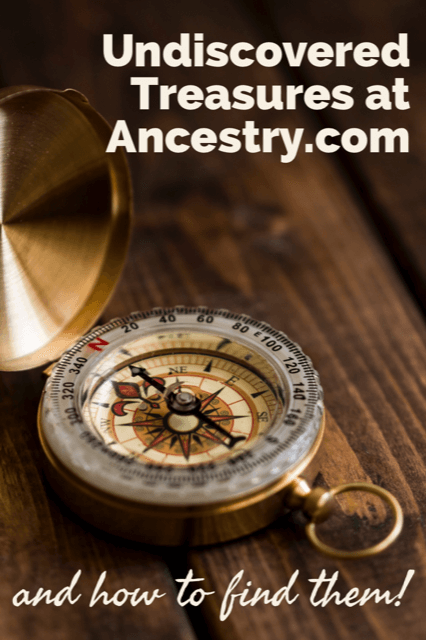
(We provide links for your convenience to the various online resources and some may be affiliate links for which we receive compensation at no additional expense to you. Thank you for your support.)
Ancestry.com is a “genealogy giant:” one of the four biggest global records resources. Whether you subscribe or have free access through your local library or Family History Center, you should not miss exploring this website for your family history.
Ancestry is also a financial investment. If you’ve been using the site for quite a while, you may be wondering if you are really getting all you can out of it’s vast genealogical record collections and many research tools.
Nancy Hendrickson, the author of The Unofficial Guide to Ancestry.com and the Unofficial Ancestry.com Workbook: A How-To Manual for Tracing Your Family Tree on the #1 Genealogy Website knows the website inside and out. Today she’s sharing four great tips for taking your research to the next level. In addition, we’ve added in some examples and additional things to consider. So let’s get started using Ancestry more effectively.

Nancy Henrickson, author of the Unofficial Ancestry.com Workbook
4 Tips for Using Ancestry.com More Effectively
1. Verify what you learn.
Any single record can be wrong, incomplete, or misread by you or by the person how indexed it. Double check the assertions made in the record by looking for that same information in additional sources. Be careful to make sure your sources weren’t getting their information from the same person or place. Otherwise, they’ll naturally say the same thing!
Nobody wants to discover conflicting information, of course. But you do want to know if something is inaccurate before it leads you down a wrong research path.
The best thing about verifying facts in additional sources is that sometimes you find NEW or BETTER information such as:
- parents’ names,
- a middle name that proves key to someone’s identity,
- or a burial place.
For example, let’s say you find an ancestor’s death date in the Social Security Death Index. While it’s a great source, don’t stop there!
Like any record, the SSDI is sometimes wrong and the information it contains is definitely limited. Use the Ancestry.com Card Catalog to see what records about death may be on the site for that time and place. You’ll find the Card Catalog under Search in the main menu.
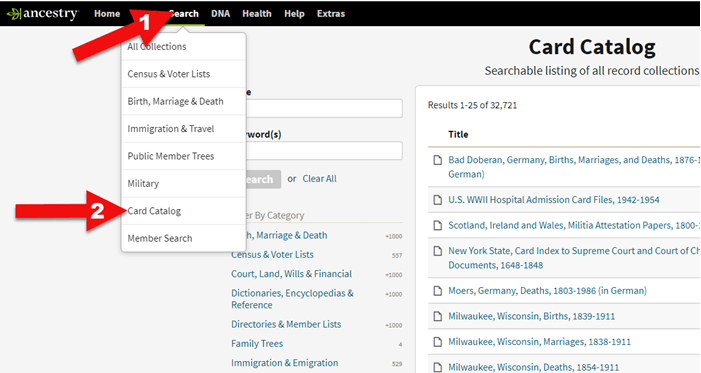
Ancestry Card Catalog
Use the filters on the left side to drill down to death records for the location you want. Remember that records collections have been created on a specific geographical level: try local, regional (such as state or province) as well as national levels.
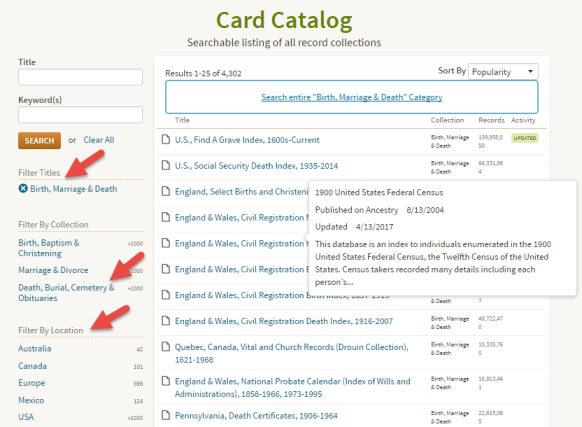
Using the Card Catalog search filters
2. Don’t just repeat what other people’s trees say.
Seeing the same information over and over can provide a false sense of accuracy. Remember, just because seven different online trees name the same parents for one of your ancestors doesn’t mean those are the correct parents. Those Ancestry users may all be misquoting the same wrong source without actually verifying the information!
You often come across likely matches in others’ trees when you review Ancestry’s automated “leaf” hints, or when you run a general search on a name. When you do, it’s simply an indication that the tree may be worth exploring. Here’s an example:
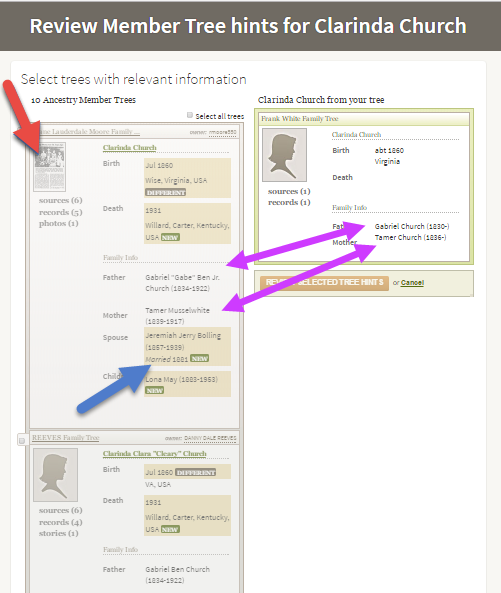
Exploring Ancestry Hints
Let’s take a closer look at this example.
The purple arrows: You can see that multiple pieces of very specific information are the same on your tree and another one.
The red arrow: You see sources attached to that person’s profile, such as the news article thumbnail image. (Note the difference with the record shown below, with just an empty profile image.) Yes, you will definitely want to review that news article!
The blue arrow: In addition to either of the above, you also see specific information that is unknown to you.
This tree profile looks promising enough you might naturally consider reviewing the tree hint and attaching it to yours. But then you wouldn’t be able to see the news article or other sources attached to that tree.
Instead, click the checkbox and then click the name of the tree to look at it and its attached sources:
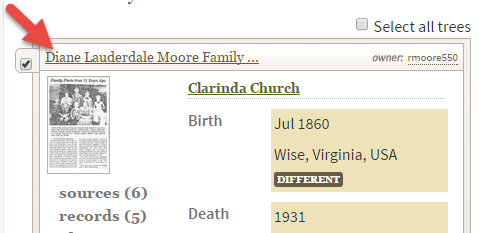
Select the tree to review it more closely.
Then you’ll be able to check out the news article along with the other sources and records attached to this person’s profile. You won’t just see what that person thinks about your common ancestor – you’ll see evidence of why she thinks it.
3. Ancestry.com has more than indexed historical documents.
Nancy reminds us that “Ancestry.com is a fantastic resource for old maps, stories, photos, published county histories, and more. For example, looking at the old maps in their collections can reveal the true nature of an ancestor’s daily life, hardships, travels, and more. And your chance of finding early American ancestors is high in county histories: there were fewer people and early settlers were talked about, even if the family wasn’t wealthy or prominent.”
Here are some of Nancy’s favorite collections at Ancestry:
This collection includes nearly 7 million records extracted from about 1,200 county and land ownership maps from across the country. These are indexed by property owners’ names.
According to the collection description, “They also indicate township and county boundaries and can include photos of county officers, landholders, and some buildings and homes.”
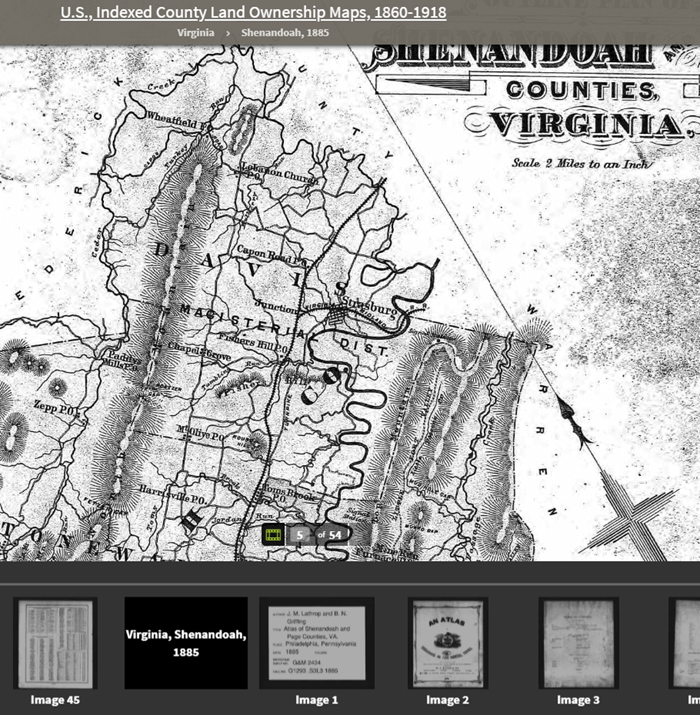
Example: Shenandoah Counties, Virginia – included in U.S., Indexed County Land Ownership Maps, 1860-1918
This is a browse-only collection of “more than 2,200 volumes of county and regional histories from California, Illinois, Indiana, Michigan, New York, Ohio, Pennsylvania, and Wisconsin.
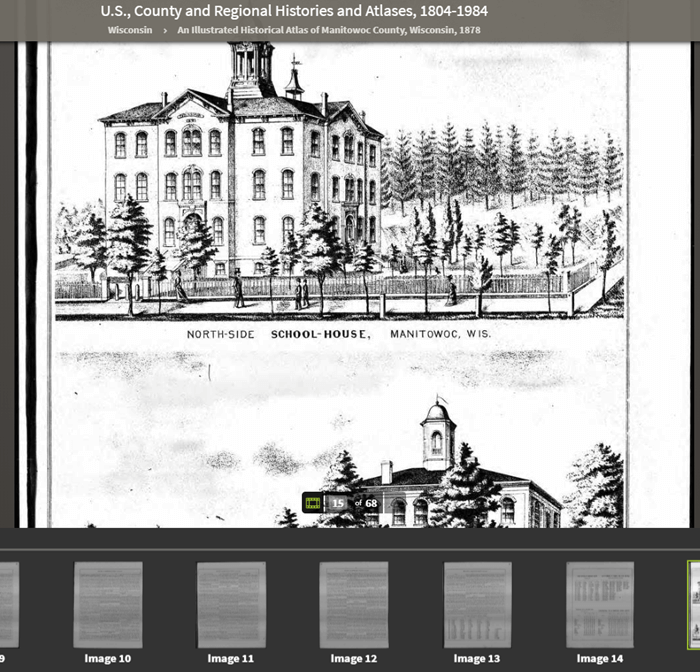
An Illustrated Historical Atlas of Manitowoc County, Wisconsin, 1878 in the U.S., County and Regional Histories and Atlases, 1804-1984 collection
In them you’ll find history, biographical sketches, maps, business notices, statistics and population numbers, pictures, descriptions of industry and business, stories of early settlement and pioneers, colleges and universities, military history, geography, and plenty of other details.”
Reminder: you can’t search this database by an ancestor’s name. Instead, look for places, and then start reading.
A collection of maps and atlases detailing land areas that comprise the present-day United States and Canada, as well as various other parts of the world. It contains a variety of maps and atlases created for different scopes and purposes, including land ownership atlases and bird’s-eye view maps.

Warrant Plan Records in the Historic Land Ownership and Reference Atlases, 1507-2000 Collection at Ancestry
Land ownership atlases usually show the names of contemporary owners or occupants of land and structures.
Some of the maps depict countries and wider geographical areas, while others depict counties, cities, towns, and smaller geographical areas.
4. Expand your search to the other Ancestry resources on the Web
Ancestry owns a lot of other web resources. Search these too!
Nancy says, “They include Find A Grave, Fold3, and RootsWeb, one of the oldest online genealogy communities around. Don’t give up! Keep looking in other places for the information you want to find.”
Find A Grave
Search results from Ancestry.com do include Find A Grave entries. Many of these contain additional information about the deceased and links to their relatives. As always, be sure to confirm the information you find here.
Fold3
Fold3 is home to millions of U.S. military records. Ancestry.com subscribers can upgrade their subscription to include Fold3 access, or you can subscribe separately.
RootsWeb
RootsWeb is a free and long-lived family history web resource, now hosted by Ancestry.
“The primary purpose and function of RootsWeb.com is to connect people so that they can help each other and share genealogical research,” says the site. “Most resources on RootsWeb.com are designed to facilitate such connections.” You can use RootsWeb in a variety of ways: search it, contribute records, upload your family tree, post your family surnames on a board others can see, and more.
Ancestry has changed one of the ways RootsWeb users have traditionally connected: Mailing Lists. According to the website:
“Beginning March 2nd, 2020 the Mailing Lists functionality on RootsWeb will be discontinued. Users will no longer be able to send outgoing emails or accept incoming emails. Additionally, administration tools will no longer be available to list administrators and mailing lists will be put into an archival state. Administrators may save the email addresses in their list prior to March 2nd. After that, mailing list archives will remain available and searchable on RootsWeb. As an alternative to RootsWeb Mailing Lists, Ancestry message boards are a great option to network with others in the genealogy community. Message boards are available for free with an Ancestry registered account.”
Learn More about Using Ancestry
Nancy Hendrickson’s Book
Nancy shares many more Ancestry tips and treasures in her Unofficial Ancestry.com Workbook. To get the most out of this book read the section on using the Ancestry.com Catalog. Nancy does 95% of her research in the catalog. The workbook is divided into topics, such as military records, so choose a chapter that fits your current goals. It’s also important to not just read the workbook, but also do the exercises. They teach you Nancy’s thought processes for how she finds specific answers or approaches certain types of problems. Then you can apply the same concepts to your own research. Don’t miss the chapter on social history. That’s where you’ll dig into everyday life. And finally, take advantage of the forms that are included. They will help you log your findings and analyze what you’ve learned.
Genealogy Gems Article
Browse-only collections at Ancestry and other genealogy websites are sometimes viewed as inaccessible, but they are actually a hidden treasure. Click here to read How to Find and Browse Unindexed Records at Ancestry – The Better Browsing Checklist. In this article you’ll learn how to access these browse-only collections at Ancestry and expand your family history research.

Read this article by Lisa Louise Cooke at Genealogy Gems

 Mocavo recently added 5000 new databases to its site (in 5 days, no less!). According to their press release, these databases include “family and local histories, vital records, city directories, newspapers, yearbooks, and more.”
Mocavo recently added 5000 new databases to its site (in 5 days, no less!). According to their press release, these databases include “family and local histories, vital records, city directories, newspapers, yearbooks, and more.”

 You may have read our previous post on
You may have read our previous post on 








 In the keyword field on the right, type in Five civilized tribes. You will see many options, but you want to click on the collection titled “
In the keyword field on the right, type in Five civilized tribes. You will see many options, but you want to click on the collection titled “
















